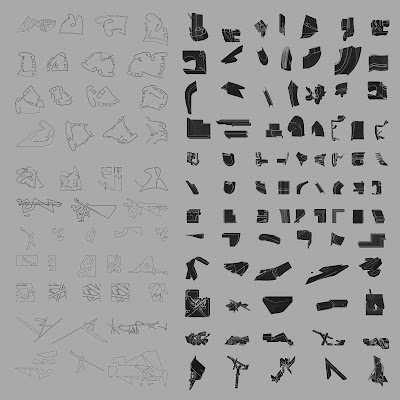T4T LAB Spring 2016. Object Redux.
Invited Professor
Adam Fure
Team: Juan Arriaza, Stefani Johnson, Chris Bell, Sydney Farris, Madison Haynes
The experiment began as we became
interested in Ronchamp as a late modernist object where inside and outside are
separated by a fold between exterior and interior. Based on its main
organizational principles of continuous change around a central void,
transformation of wall to volume/ volume to wall and creation of entry through
the repetition of elements, we decided to reconfigure and distort elements and
extrude them to produce 3d manifestations of these. We began to denote these
new primitives as “chunks,” and proceeded to create an index from which compositions
were created. By sweeping, extruding, lofting, and booleaning shapes and forms
derived from the plan of Ronchamp individually, the group members then compiled
the sum of their work to assemble new objects. Through the process of combining and distorting chunks, elements
which once functioned as parts of a plan began to lose their definition and
begin to take on a new autonomy, driven by the inputs of each team member.
Trying to understand if the product
was a simple sum of different chunks, we decided to replicate the experiment
with a different building. The Jewish Museum was selected as it also follows an
irregular organization around a void as well as the
notion of the fragmented line as an organizing principle. The process of
reorganization of the plan and production of chunks was repeated to create a
new irreducible object.
In computing, from least to most
physical, there are four layers of information: application, transport,
internet, and link; where the application is the interface we actually engage
in and the link is the physical medium of transport. The deeper scripting
languages go and the further they move from our understanding, the more
boundless and raw the information becomes. The “critters” we engage with are
the most abstracted result of the plan of a real building; but while they’re
entirely hypothetical we are more able to interface with them than with the
original drawing, or data.
With Ronchamp and The Jewish Museum
as precedents, the plans are used as genetic framework from which “chunks” are
derived and categorized. The aforementioned process has been repeated so many
times that the final productions have logical depth, meaning a large amount of
data has been discarded to reach the final — a conventional design process with
an unconventional product. We began to ask: Does folding an object (in the
Deleuzian sense of The Fold) automatically create a new irreducible product or
is the folded object identical to the new object because it retains the same
formal qualities? The action of unfolding both opposes folding and continues
it.
Because each chunk was extracted and
operated on by different people, their ultimate combinations were the products
of entirely different evolutionary processes. Each “chunk” acts as a pixel in
that the assembly of all these similar building blocks reads as the unity of
infinitesimal parts. And each of the final conglomerations is the manifestation
of a variety of arrangements and productions. “The [referenced plan] becomes
distorted to such a degree as to render the [‘critter’] a denial of
repetition,” as it develops a particular character through its new autonomy.
Point-of-view is not limited to human perception. The irregularity and
lottery-like selection and combination of chunks creates a final model which
changes continuously around its axis, alternating from volume to wall, wall to
volume. The unity of the objects’ inherent multiplicity produces a gestalt
reading, as the self-organized chunks attain their own reality.
In this way, the project redefines
abstraction by unfolding rather than folding the original data.






























